Tank M551 Sheridan. Combat use
Tank M551 Sheridan was originally developed as a high-tech counterweight to the Soviet tank Armada in Central Europe. The developers have relied on more long-range and accurate weapons. But not only with us everything turns out as always. During its first combat deployment, instead of hordes of Soviet tanks, the Sheridan saw only impassable Vietnamese jungle, where there was no one to surprise with the high-tech filling. Yes, and the “Shillleys” were not delivered. Although who needed them there?
In 1966, the Pentagon first proposed testing the Sheridan of the American Army in Vietnam, but at that time the cannons for the gun were still incomplete (problems with the cartridges), so the tank crew gave the car a caustic, but apt nickname - “300 machine gun” gun platform). In the 300,000, by the way, such luxury cars as Lincoln Continental or Cadillac Eldorado could be bought for 70 $ - such is the arithmetic. The March 7000 report on the use of armored vehicles in Vietnam clearly indicated the need for a light tank, the mobility of which would be no worse than that of the M1967, and that security and firepower would be higher. While the M113 itself was simply asking for this role, the report questions the value of Sheridan because of the lack of anti-personnel ammunition, poor fitness for night combat, poor booking and the lack of a dozer kit. The report was not supposed to make any changes to the design of the car specifically, but at OTAC (the American equivalent of our armored vehicle control) they saw a chance to rehabilitate and at least somehow justify the mass production of the “raw” tank. The following developments were initiated: a new M551 shrapnel ammunition, a special set of mine bottom protection and an increase in the capabilities of vehicles in night combat. By 625, when, finally, everything was ready, including the shells brought to mind, they began to implement a plan to retool the 1968 and 1 squadrons (similar to our company) of the 3 armored cavalry regiment Vietnam This plan caused a noticeable rejection in the troops due to Sheridan’s vulnerability to RPG mines and RPG grenades, especially in comparison with the M4A48 tank, which was in service and tried to be replaced with a new “cardboard armored car”.
The decision to deploy the M551 in Vietnam was largely an initiative of General Creighton Abrams - Commander of the United States in March 1968. He reluctantly approved the role of Sheridan in the structure of the army while he was deputy chief of staff, and ordered the operational planning center in Saigon to examine the issue in more detail in July 1968. Given a number of conflicting opinions, Abrams wanted to get feedback primarily from users, not developers. To dot the "i", a number of military specialists from the armored school at Fort Knox (those who worked directly with the new machine) and the commander of the 73 tank battalion, where the Sheridans were field tested, were summoned to Saigon. After a long joint briefing with Lieutenant Colonel Burton Boudinot, head of the operational planning center, the experts came to the unanimous opinion: М551 in its actual performance characteristics is not suitable for combat operations in Vietnam. Abrams hastened to clarify whether it is possible at least a limited use of tanks, due to the simple fact that a huge number of new expensive Sheridans were commonplace dusting in warehouses. Budinot proposed to deploy 27 machines, sufficient for the formation of a squadron, deprived of their guided missiles and a complex fire control system, as well as with enhanced armor due to increased mine danger in Vietnam.
Modified for Vietnamese realities, the tanks were sometimes called "Sheridan-two-boxes". The fact is that the machines removed all the electronics units associated with the launch and control of Shillelah ATGMs, leaving only two empty boxes. The vacated space was used to accommodate additional BK for the machine gun. Racking rocket laying remade to store conventional shells. A total of about 230 M551 were manufactured or converted for firing exclusively kinetic ammunition. Abrams shared his reasoning with Colonel George Patton, commander of the 11-th armored cavalry regiment, and he, in turn, suggested using new tanks at the same time as part of the division and the regiment. So instead of 27, Pentagon units sent 64 — an amount sufficient to complete two squadrons.
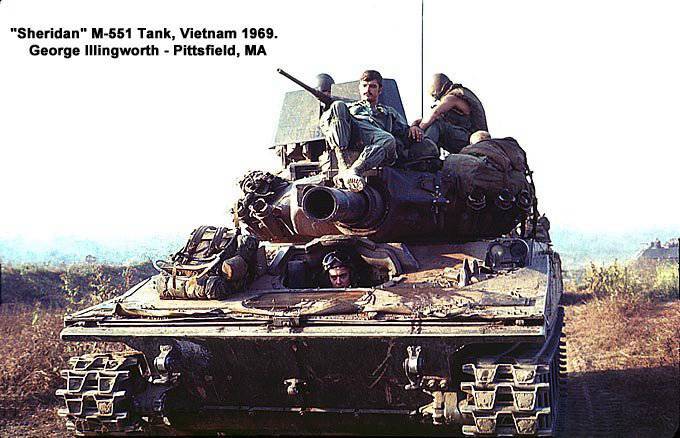
The first Sheridans arrived in Vietnam in January 1969. They were manned by the 3 squadron of the 4 battalion of the 25 tank division and the 11 armored cavalry regiment. In the 11 regiment, a mixed fleet of M113 armored personnel carriers and medium tanks M483 were used before, and they were not particularly keen on replacing this whole economy with a light-armored vehicle. The opinion changed slightly after the first battle that occurred during the pre-dawn 29 hours of January 1969. Two Sheridans were at a roadblock, near the Long Binh highway, when movement was noticed. Having turned on two powerful searchlights, the crews attacked the advancing infantry with the M625 “Hive” shells. Shrapnel literally annihilated the enemy. The next morning, 125 corpses were found and clear evidence that many more wounded, able to move on their own, crawled away from the carnage.
Anti-tank M409 also found their use - against bunkers and various buildings. Since a single doctrine for the use of new technology did not exist yet, both divisions developed their own tactics. In the 11 Infantry Corps, in one of the three reconnaissance units of each armored cavalry platoon, two M113s were replaced by three M551s. Such a move increased the mobility of intelligence and its firepower. In reality, tank-equipped units often interacted with other units in order to balance the balance of power. Shrapnel shell was a very popular tool. In just the first three months of the fighting, the Sheridans shot 1461 shrapnel, 350 cumulative shells and 431 thousands of machine-gun cartridges.
In 25, the tank one made a more controversial decision - they replaced the M48А3 tanks with Sheridans. The old "Patton" was respected as a durable and reliable tank, which, thanks to its weight and power, perfectly "ground" the jungle. The fourth battalion lost its first M551 15 in February of 1969. The car hit a mine, an explosion instantly killed the driver and then caused the detonation of the ammunition. The confidence of the 3 th squadron was significantly undermined, since the good old M48 would have got off in this case with a slight fright. Of the 64 arrivals on the battlefield, Sheridanov had blown up ten mines in the first three months of operation, but only the first incident led to the complete destruction of equipment. The use of special titanium overlays on the bottom reduced the losses among the mechanics, but, in any case, the explosions on the mine completely deactivated the tank. According to the results of the trial three months, the army was ready to adopt a couple of hundred new cars, subject to mandatory revision and elimination of the identified operational deficiencies.
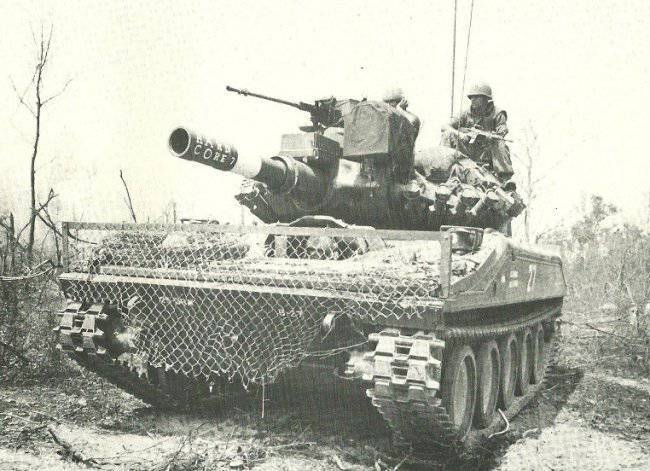
The main enemies of Sheridan in the jungle were the ubiquitous RPG-2 and RPG-7 anti-tank missiles. In the first three months, 12 of 64 machines were hit by grenade launchers. 5 damaged tanks were not recoverable. In case the RPG projectile hit the turret, there was a high probability that the ammunition load would detonate. The explosion and the subsequent fire left at the scene only a puddle of molten aluminum and a burnt-out tower frame in the midst of smoking debris. In such cases, the trapped inside the crew had little chance of escape, so many preferred to ride armor, rather than inside. Not everything was in order with ergonomics. Due to the narrowness of the fighting compartment, the crews were very tired, and their combat effectiveness was significantly reduced.
Sheridan has become a big headache for technical staff. The tank was experiencing nightmarish problems with the complex electronic filling of the tower. The control system of firing parameters often malfunctioned, and the technicians who were overwhelmed by wandering faults simply short-circuited the electric transmission of the gun and the tower searchlight, so that even if the “smart” electronics did not allow to shoot, it was possible to “shoot a light bulb”. The increased humidity of the jungle spoiled flammable nitrocellulose sleeves. During the trial period, more than 40 misfires were recorded, which created a real problem, since the only way to get the failed projectile was to get a gun out of the muzzle. Naturally, it was especially pleasant to do it under enemy fire ... And there were losses. And just like that, the munitions themselves were vulnerable to vibration damage during movement and shooting. The engine suffered frequent overheating, mainly due to broken drive belts of the fan, and the tendency of the radiator with air filters to quickly clog in the natural conditions of Vietnam. 25 engine tanks of the first batch after three months of operation to be replaced.
Almost an indispensable improvement for all of the Vietnamese Sheridans was the transfer of the commander's handle of fire control to the top of the tower, so that the commander could, outside, turn it and shoot from the cannon. The gun was often pre-loaded with shrapnel ammunition, so that, having come under unexpected shelling, it was possible not to take a special look at the eye, turn the turret and burn the enemy from the heart before diving into the fighting compartment. Cartridges for coaxial machine guns also frustrated users due to the low box capacity and the tendency to seize weapons. They found a way out quickly - massively used larger boxes from M48 tanks. The combat and climatic conditions of Vietnam required a lot of field modifications of the tank. One of the first was the installation of improvised shields on the commanding machine gun, but it was somehow uncomfortable for him to lean out to the waist under bullets. Two more upgrades were longer exhaust pipes (when parked in thick bushes a tank was mercilessly hunted by the crew of the exhaust) and additional ammunition at the stern of the tower.
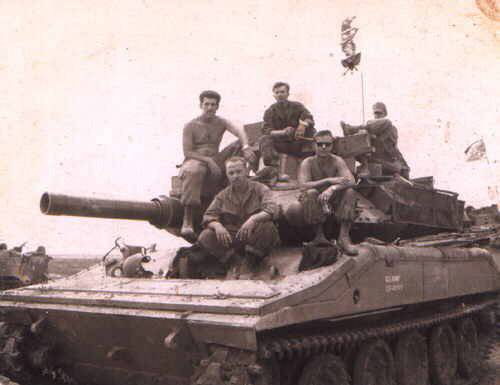
Despite the multiple difficulties in using the M551 in Vietnam, it ultimately proved its usefulness as an alternative to the M113 BTR, but didn’t become an adequate substitute for the old M48. Sheridan's main advantage over Patton was its increased mobility on soft soils. So the re-equipment of the squadrons continued, but the tank never enjoyed the special love of tank crews and was considered troublesome, and even dangerous. In total, about 90 machines were irretrievably lost during the fighting.
Peace Service
Simultaneously with combat tests in Vietnam, the Sheridan tank was actively introduced into armored cavalry units in the United States, Europe, and wherever possible. Often accompanied by civilian technicians, so that they eliminate multiple deficiencies during the service. The number of M551 in Europe by 1974 was 576 units in the 32 of various units.
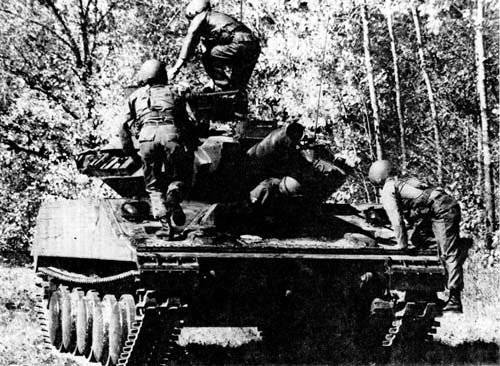
М551 in Germany, on exercises
The car turned out to be difficult to master because of the sophisticated weapon control system, which ultimately led many tankers, following the example of their Vietnamese colleagues, to simply reconnect the trigger shortly, bypassing multiple sensors and fuses. The salvo of the armored car was impressive. Light tank when fired by cumulative ammunition just got on its hind legs. The first two or three track rollers (out of five!) Came off the ground. The arrows were strictly instructed when shooting tightly press their faces to the sights, so as not to get a tank in the forehead. Sheridan's gunners in the parts were easy to identify by the characteristic bruise around the eye. The design of the suspension is desperately lacking guide rollers. Driving at low speeds caused characteristic vibrations that blazed all the available mechanisms. And if such a “razboltay” after the march also went to the shooting, then, when fired, spare parts from the tank tritely flew off (a searchlight, machine gun guards, etc.). Shillelau missiles on the exercises were shot only on major holidays, they were very expensive.
Attempts were repeatedly made to improve the ATGM indicators, which was partially succeeded (they increased the range from 2 to 3 km). In the course of the passage of the service vehicles, the life of the gun in the 100 shots was set. The barrel literally cracked, although it was smooth-bore, but the presence of a guide groove to stabilize the rocket weakened the structure. In the future, the survivability of the gun was brought to 200 shots, although initially counted on the 500. Longevity gun added by reducing the guide groove.
The appearance in the troops of the M551 with its considerable firepower caused a debate in the troops about the role of the armored cavalry regiments in Germany. During 70-x, this issue was repeatedly raised, but they did not come to a single solution, largely due to the short life span of the new tank.
According to the results of combat and combat use Sheridan significantly upgraded. Thus, the shield for the commander's machine gun became standard equipment, the twin machine gun М71 was replaced with М240 and the AN / VSS-3 infrared searchlight was installed on the tower. One of the most significant modifications was the installation of a laser rangefinder AN / VVG-1. Sheridan is the first American serial tank to receive this device, since it is especially important to know the exact distance to the target for firing low-ballistics shells.
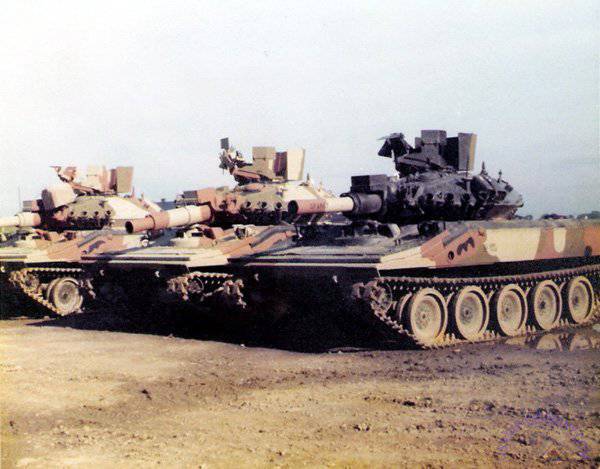
M551 has never been particularly popular in the military, all because the list of necessary improvements was endless. Despite the impressive caliber, the massive recoil of the gun was difficult compatible with firing guided missiles.
In the summer of 1977, Sheridan, together with his equally unlucky fellow M60А2, were sentenced to a meeting at the command meeting. The procedure was completed in 1980 year, the exception was the 82-I Airborne Division, where the tanks were left in service, because there were no other airborne tanks in the United States, and there are still no, well, about a dozen remained in the National Guard units. The rest of the equipment was scattered around the reserves.
Airborne operations
The 82 Airborne Division was the only unit that regularly used M551 tanks in landing operations.
In total, there were three ways of delivering the car to the desired place by air: by landing method (just by plane to the airfield), parachute dumping and low-flying aircraft dumping. With the advent of such aircraft as the C-130 and C-141, Sheridan could be quickly delivered to any available airfield. If it was necessary to send the tank literally “from ship to ball”, then the other two methods were suitable. Normal dumping was carried out using the parachute system and a special shock-absorbing pan, there are no questions here, everything is clear. But the second method was more cunning. At first, the C-130 descended so low to the ground and flew as slowly as possible, then the ramp opened, the “unloading” parachute started and the packaged tank pulled out, it fell from the 1,5-3 meter at a speed of 150-170 km / h and then, to a full stop, the 50-60 also rode merrily, sometimes to some degree. After a series of accidents on the test with such unloading tied.
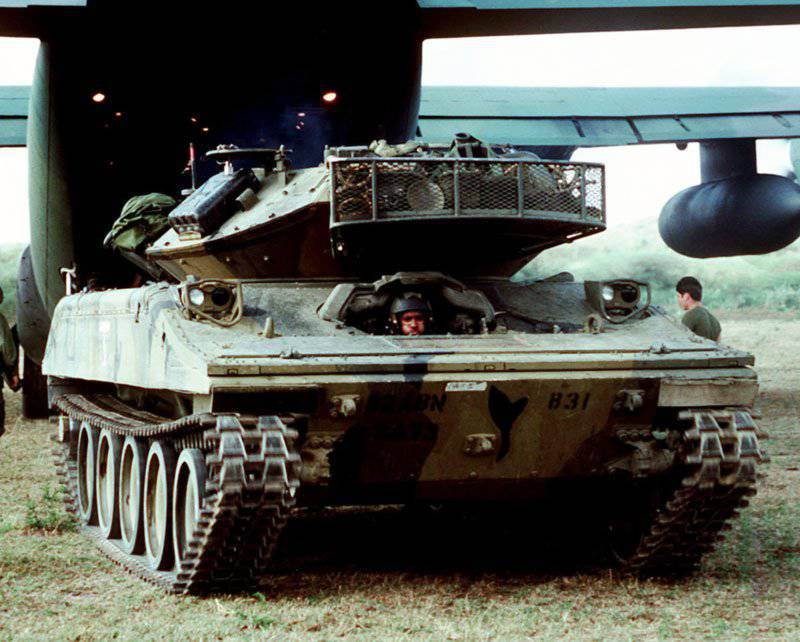
It is possible so
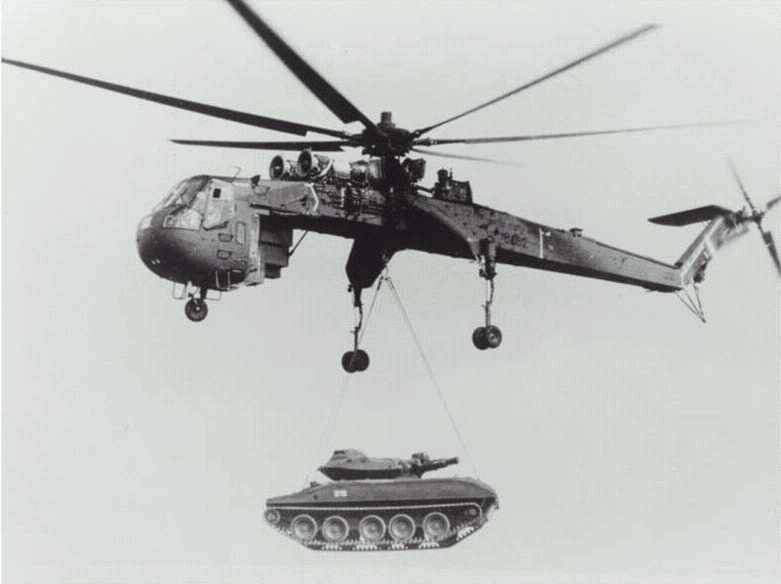
Sometimes so
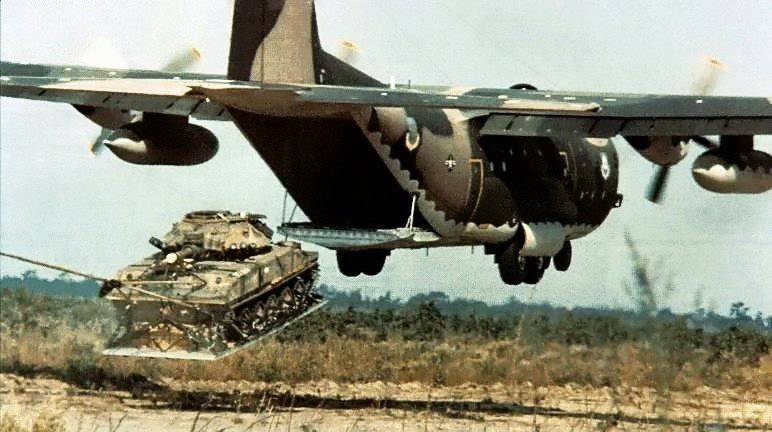
And so - it is better not to
From 1977 to 1980, the remaining M551s were again upgraded, in particular, on some machines they replaced the aluminum blocks of the 6V53T engines with cast-iron ones, replaced the smoke screening devices with more modern ones, installed new night vision devices and thermal sights.
Due to the fact that many serviceable vehicles stood aimlessly in storage, an attempt was made to remake Sheridan into a sort of analogue of the Soviet BMD, removing the massive tower and replacing it with lighter weapons. But it didn’t go further than a pair of prototypes. After 1979, the tank found the most extensive use at the National Army Training Center at Fort Irwin. The 330 vehicles were converted into visual copies of Soviet armored vehicles and used on the trainings as a conditional opponent, up to the full development of the service life by the year 2004.
Airborne assault operations involving Sheridan
Operation The Right Cause in Panama was the first combat use of the tank since the Vietnam War. The purpose of this operation was the removal from power of the current President of Panama M. Noriega, in order to then establish a pro-American government and maintain control over the Panama Canal. While the political crisis was brewing, a platoon of four M551 secretly dropped into Panama in November 1989, tanks were placed in the hangars of the Howard military airbase, and the crews walked around the territory in the form of the 5 Infantry Division. Support by tanks was recognized as vital, as the Panamanian self-defense forces possessed only a small amount of lightly armored vehicles.
The 82 Airborne Division's rapid response brigade was dropped in the pre-dawn darkness of December 20 at Tocumen Airport and brought with it 1989 Sheridan tanks, also dropped by parachute. An incident happened to two of them: on hitting a marshland, the cars boomed into the mud right up to the tower, as a result one was destroyed and the second one was damaged. Crews landed separately. Then the "armor" drove the infantry to the desired targets, evaporating Panamanian roadblocks with their 10-mm shells along the way. Experts note the high psychological impact of tanks on their troops as well as on enemy troops. The soldiers were very encouraged by the presence of large-caliber artillery in their ranks, and the enemy Sheridanov was very afraid, and there were even cases when Panamanian soldiers refused to fire convoys or positions where the M152 were.
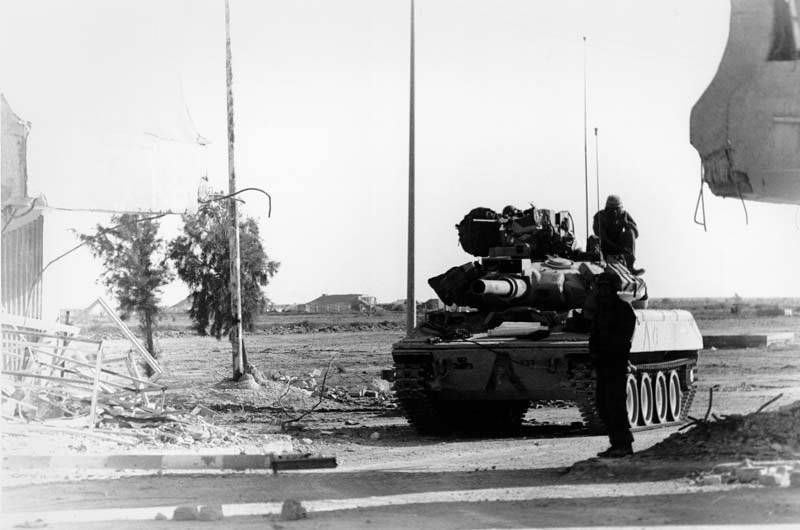
After the Iraqi invasion of Kuwait in 1990, the Sheridans once again took part in the military operation, Desert Shield. This time, the 82 airborne troops were deployed in Saudi Arabia to prevent possible aggression from Iraq. М551 remained the only American tanks on the territory until the rest were taken by sea. As part of the follow-up Operation Desert Storm, the 82 Airborne Troops were used as flank protection in the desert while attacking remnants of the Iraqi 45 Division. In this battle, at least a single (and only) use of Shilleyla in the battle against the T-55 tank (or Type 59) was recorded. One rocket of 88 thousands. In the operation, the tanks showed themselves well and did not even break. But it was the last act of the play. Having safely reached 2004, almost all tanks from the 82 Airborne Troops were written off, leaving only a couple for limited tactical operations, and this only because there is still no adequate replacement.
Sources used:
Magazine "M551 SHERIDAN: US Airmobile Tanks 1941-2001" by Steven J Zaloga
http://en.wikipedia.org/wiki/11th_Armored_Cavalry_Regiment
http://en.wikipedia.org/wiki/M551_Sheridan
http://btvt.narod.ru/2/nam1.htm
http://forum.shrapnelgames.com/showthread.php?t=28817
http://www.bragg.army.mil/82nd/Pages/History.aspx
Please note: during slow-motion reproduction of a shot, it is clearly visible how the two front rollers come off the ground
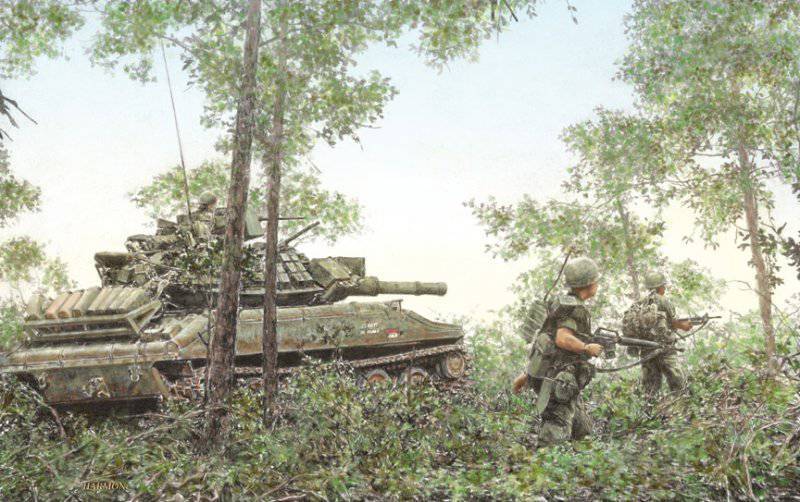
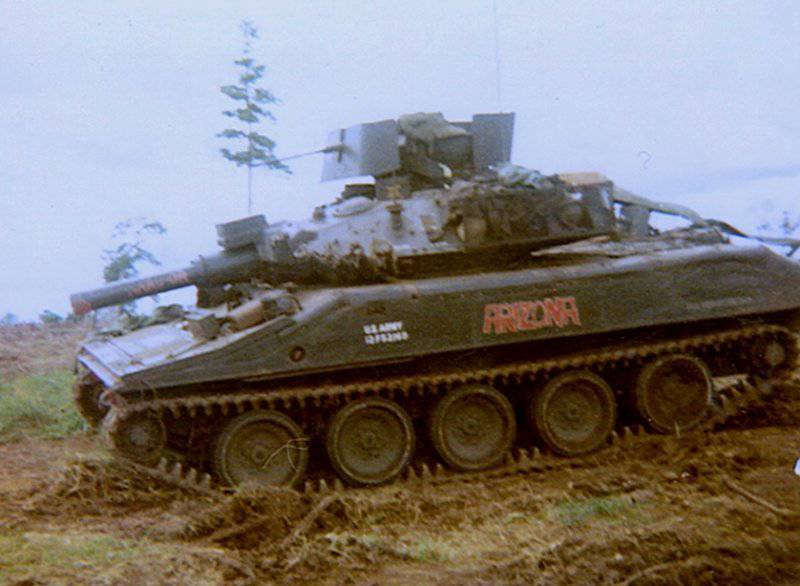
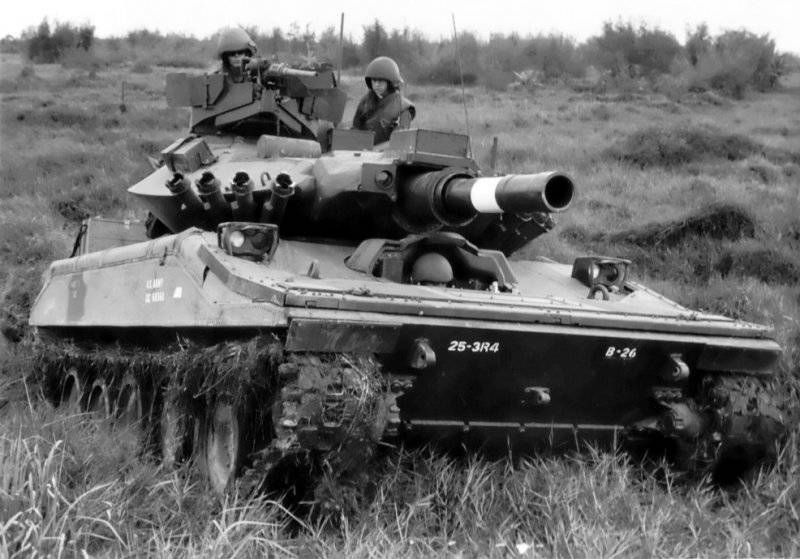
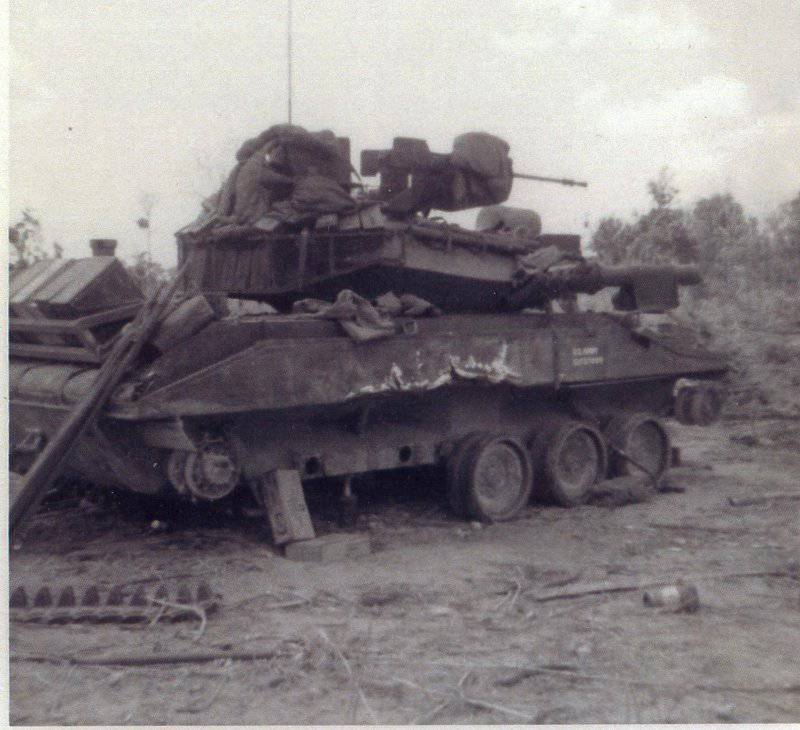
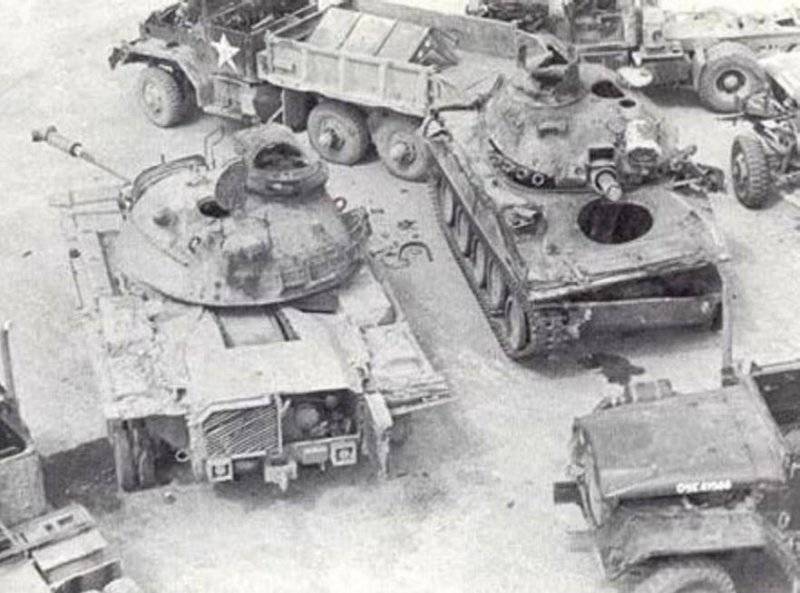
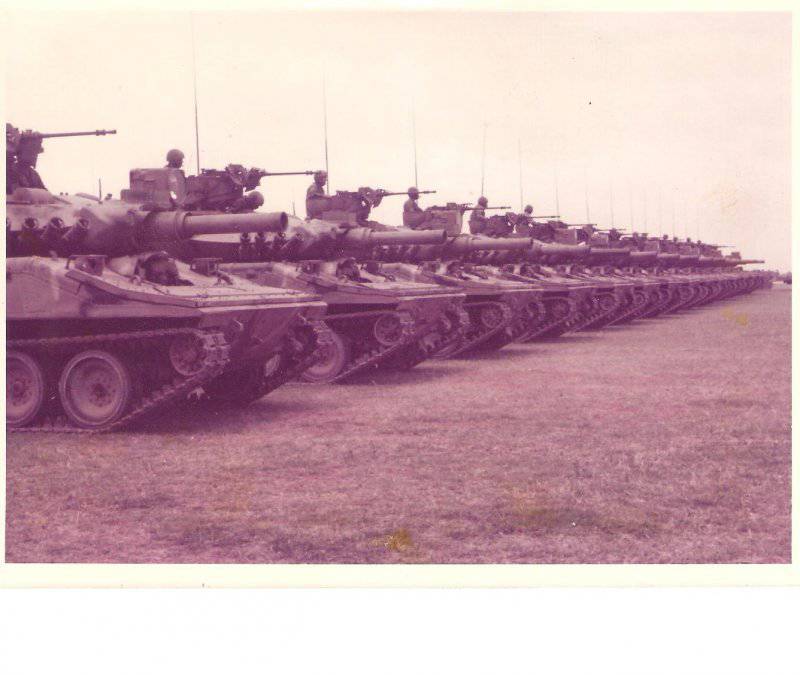
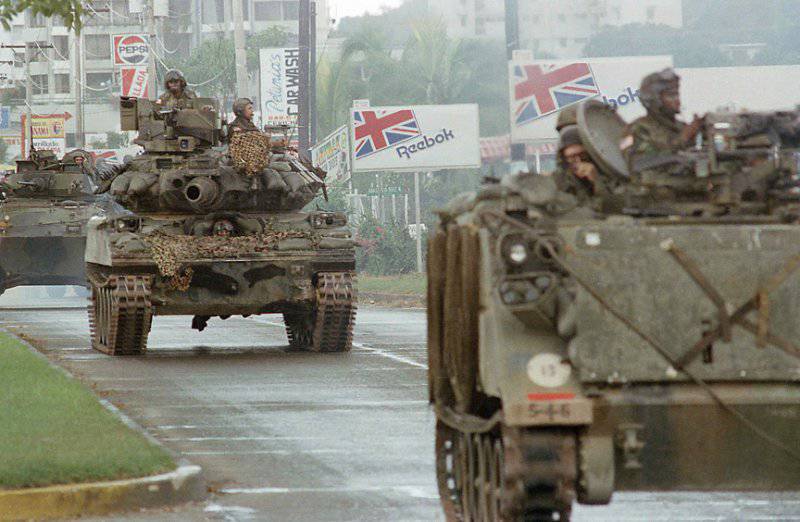
Information